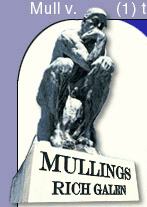|
|

|


We the People
Rich Galen
Monday January 3, 2011
Click here for an Easy Print Version
When the House opens for business at noon on Wednesday, Republicans will hold a tag-team reading of the U.S. Constitution which is an excellent idea. Most of the incoming Freshmen will not have read any major part of the Constitution since 11th grade social studies, but it is the rule book and incoming Speaker John Boehner wants to make sure everyone understands that.
The 112th Congress will not begin today even though Clause 2 of the 20th Amendment states:
The Congress shall assemble at least once in every year, and such meeting shall begin at noon on the 3d day of January, unless they shall by law appoint a different day.
The 20th Amendment, which was ratified in January, 1933 changed the initial meeting day of a new Congress which had been, according to Article I, Section 4:
The Congress shall assemble at least once in every Year, and such Meeting shall be on the first Monday in December unless they shall by Law appoint a different Day.
Keep in mind that was the first Monday in December of the year following the elections. If the 20th Amendment had not been ratified, the Democrats would continue to control the House and Senate as a lame-duck 111th Congress until next December 5th.
The 20th Amendment also changed the date of the beginning of a Presidential term from March 4 to January 20.
Senators, remember, were not selected by election of the masses prior to the ratification of the 17th Amendment in 1913. According to Article I, Section 3:
The Senate of the United States shall be composed of two Senators from each State, chosen by the Legislature thereof.
In the 18th century, transportation and communications were such that it was often difficult to determine who had won which election. For the winners, getting their affairs in order and making the trip to Washington, DC (when it became the seat of government with the signing of the Residence Act in July of 1790) was often an arduous and time-consuming ordeal.
By the way, the Residence Act, which established what we now know as the District of Columbia, passed the House by a vote of 31-29 and the Senate by a vote of 14-12 and originally included land ceded by both Maryland and Virginia. The government didn't think it needed the Virginia piece so the land which now makes up Arlington County and Alexandria City was returned to the Commonwealth.
To show there is nothing new under the sun, the compromise which put the Capital in its current location had to do with resolving an argument between northern and southern states over paying off the debts which had been accrued during the Revolutionary War.
The deal was, if the northern states agreed to put the U.S. Capitol in a southern area (as opposed to Pennsylvania which was their choice) then the southern states - which had largely paid off their debts - would agree to transfer the northern states' debts for the war from the states to the federal government.
President Washington liked the Maryland-Virginia plan because his home, Mount Vernon, is only about 15 miles from the District so he could, in effect, walk to work.
It is also useful to remember that the Constitution was Governance Two-Dot-Oh. The original government document, the Articles of Confederation, were so carefully drawn to limit the power of a central government that they soon became unworkable and what became the Constitutional Convention which convened on May 25, 1787.
Even at that, the Convention was designed to refine the Articles of Confederation but, "the stated goal of the Convention - the revision of the Articles of Confederation - was quickly discarded, and attention given to more sweeping changes."
The Constitution was ratified on June 21, 1788 when the ninth state, New Hampshire, ratified it. But it wasn't until the two largest states, Virginia (June 25, 1788) and New York (July 26, 1788), ratified it that it was clear that the Constitution would be the governing document of the young republic.
The first Congress met on March 4, 1789 which is commonly noted as the date the Constitution became the supreme law of the land. President Washington wasn't sworn in until April 30 that year and other part of the document became effective when the infrastructure was available to support them.
Nevertheless, it is a remarkable document. When it is read aloud in the U.S. House this week, you might think about TiVo-ing or DVR-ing it and having the kids sit and watch.
On the Secret Decoder Ring today: TONS of links today to the history of the Constitution. Also a Mullfoto which we might all want to write down and the Catchy Caption of the day which is the preamble to the U.S. Constitution.
--END --
--END --
Copyright © 2011 Barrington Worldwide, LLC
Become a
Paid Mullings Subscriber!
(To join the FREE mailing list or to unsubscribe Click Here)

Current Issue |
Secret Decoder
Ring | Past
Issues | Email
Rich | Rich
Who?
Copyright �2007 Barrington Worldwide, LLC | Site design by Campaign
Solutions. | |
|


